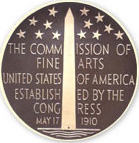
The controversy over the future Eisenhower Memorial has involved many actors: congressmen and congressional subcommittees, the Eisenhower family, the National Civic Arts Society, the National Capital Planning Commission, and assorted political pundits. A small but influential body central to the process has received less public attention. The U. S. Commission of Fine Arts was the brainchild of Chicago architect Daniel H. Burnham, who with Charles F. McKim, Augustus Saint-Gaudens and Frederick Law Olmsted, Jr. was the author of the so-called McMillan Plan, which restored the monumental core of Washington, D.C. to L’Enfant’s vision. Burnham saw the need for an official body to oversee the implementation of the artistic aspects of the plan, and in 1910, Congress created the Commission of Fine Arts, with seven commissioners, chosen from qualified design professionals, to be appointed by the President for a period of four years. Although the Commission reviews the design of all federal buildings in the District, as well as the design of coins and military medals, its chief responsibility is “to advise about the location of statues, fountains, and monuments in the public squares, streets, and parks of the District of Columbia . . . and upon the selection of artists for the execution of the same.” In other words, a sort of art police.
[Full disclosure: I am completing my second term as a member of the CFA.]
